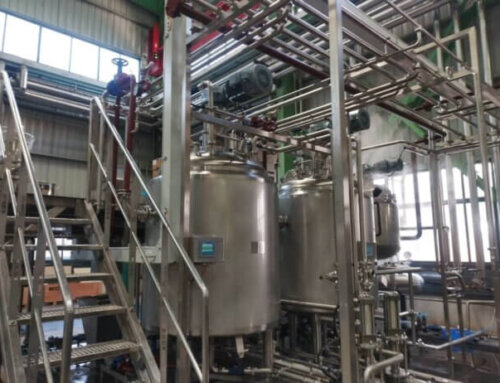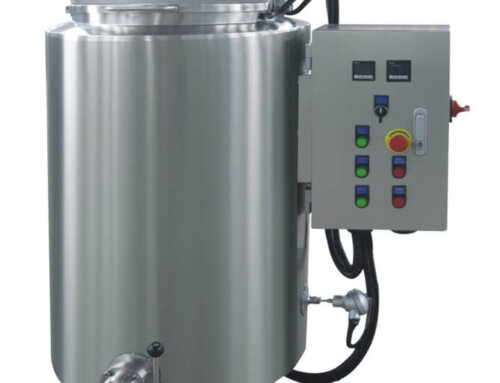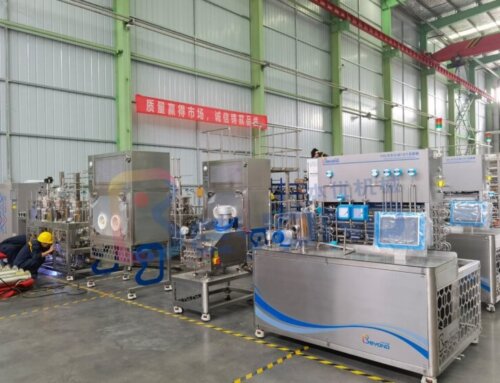Aromas Substance Recovery Introduction
Fruit aromas are volatile substances that characterize the typical characteristics of a fruit or fruit juice. The aromatic substances of various fruits are a mixture of different volatile components, which are various volatile aromatic components formed during the fruit ripening process, and these components are mixed together to form the aromatic substances of the fruit.
During fruit processing, crushing and juicing destroy the relative biochemical balance inside the fruit, causing a series of biochemical reactions in the raw materials, affecting the aroma and flavor of the fruit. In addition, the crushing process will also intensify the activity of microorganisms and produce substances with unfavorable odors such as ethanol and acetic acid. Therefore, the fruit raw materials should be squeezed as quickly as possible after crushing, and the aromatic substances in the juice should be recovered.
Generally speaking, the content of aromatic substances in fruits is between 1-10mg/100g. The fruit mainly contains the following volatile aromatic components: hydrocarbons, mainly terpene, monovalent alcohol, terpenacohol, monocarbonic acid, ester, aldehyde, ketone.
In order to obtain most of the aromatic substances, the water evaporation required for pome fruits under normal pressure is 10%, and the stone fruits such as peach and apricot raw juices contain more aromatic substances that are difficult to volatilize, and the water evaporation needs to reach 15%-20%, the water evaporation of cherry juice is 20%-30%, and the water evaporation of berry fruits such as strawberries and raspberries should reach 30%-40%.

Aromas Substance Recovery Process
There are 5 extraction methods for aromatic components: steam distillation, cold pressing, extraction, adsorption and supercritical fluid extraction. Distillation often causes fraction loss, and during steam distillation, the aromatic components are at high temperature and are easily hydrolyzed to form useless impurities; the extraction and adsorption methods can be operated at low temperature to avoid hydrolysis, but cannot avoid the existence of solvent residues in the essence. Since the solvent must be removed by distillation, harmful thermal degradation reactions cannot be ruled out; supercritical fluid extraction is an ideal extraction method, but the equipment is expensive and the operation is complicated. Cold pressing is an essential oil extraction method that has been re-recognized and valued in recent years.
In the recovery equipment of fruit juice aroma substances, the evaporation process is usually used to separate the aroma substances, and then the continuous countercurrent rectification process is used to obtain the aroma substances in the rectification tower. The device is divided into a feeding system, a heating evaporation system, a fractional distillation system and an aromatic substance collection system.
Distillation is a unit operation in which components in a liquid mixture are separated from each other according to their different boiling points. If fruit and vegetable juices are heated to boiling but only partially vaporized, the concentration of components with low boiling points will be higher in the vapor phase than in the liquid phase, and the concentration of components with high boiling points will be higher in the liquid phase than in the vapor phase. Similarly, when the steam in the fruit and vegetable juice is partially condensed, the concentration of the volatile components in the condensate is higher than that in the vapor phase, and vice versa. After repeated partial vaporization or partial condensation, the relatively pure volatile components can be obtained in the vapor phase, and the less volatile components can be obtained in the liquid phase.
Designed to extract aromas and essences from a flow of natural juice, the aroma recovery unit is able to quickly obtain the best results. It consists of several vacuum condensation columns that condense the aromas using cooling fluids at different temperatures. The aromas are then extracted by flash evaporation and, depending on the grade of quality, sent to one or more collection tanks or later added again to the product. This allows for the recovery of aromatic essences that would otherwise dissolve in the air.

Aromas Substance Recovery Example
The installation of the aroma substance recovery device on the concentration equipment is great progress in the fruit juice concentration process, which makes a qualitative leap in the quality of the concentrated juice and also meets the consumers’ pursuit of natural requirements.
Aromas substances recovery from citrus fruits
When manufacturing citrus fruit juice concentrates with recycling equipment, it must be taken into account that the aromatic substances of citrus fruit raw materials are composed of two parts: one part of the aromatic substances is dissolved in the pulp juice, and the other part exists in the form of orange peel oil emulsion. When making citrus fruit juice, only a small amount of orange peel oil emulsion enters the juice from the peel oil cells, the highest is only 0.3ml/L. In the process of evaporation and concentration, the water vapor escaping from the original juice also forms two parts after condensation: one part is the aromatic liquid, and the other part is the aromatic oil floating on the surface of the aromatic liquid; In the fruit juice industry, ordinary aroma recovery devices can be used to recover the aroma of citrus fruits, but the separator in the recovery device must be able to separate the aromatic oil floating on the surface of the distillate from the distillate.
In the production of concentrated citrus juice, the first effect evaporator of the concentration equipment evaporates about 15%-25% of the water, and the water vapor enters the aroma recovery device, from which the concentrated liquid of the aromatic substance is produced, and the residual liquid with a very low content of the aromatic substance then enter the next stage evaporator to continue to concentrate until the specified concentration is reached.

Recovery of aromatic substances from apple fruits
The raw apple juice obtained by squeezing the juice contains some turbidity particles, and the turbidity is removed by sieving or centrifugal separation, and then the raw juice is heated by a heat exchanger and then pumped into the aroma substance recovery device. In the recovery device, a part of the original apple juice evaporates, and the aromatic substances escape together with the water vapor during the evaporation process. Under normal circumstances, when recovering the aromatic substances, the water evaporation of the original juice is 15%, and the concentration of the concentrated apple aroma substances is 1:150.
In the rectification tower of the recovery equipment, the concentration of water vapor rich in aromatic substances increases continuously and finally separated in the biological form of aromatic substance concentrate.

Aromas substance recovery from grape
Grape juice concentration is carried out on the rapid concentration equipment equipped with aroma substance concentration device. Due to the azeotropic characteristics of aromatic substances, about 20%-30% of the water escapes from the original grape juice along with the aromatic substances when producing aromatic substances. A concentrate of grape aroma substances at a concentration of 1:150 can be recovered from the steam.




